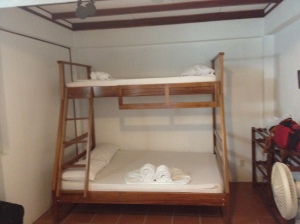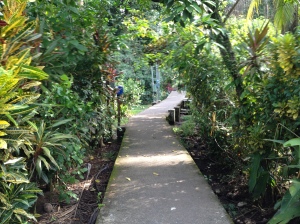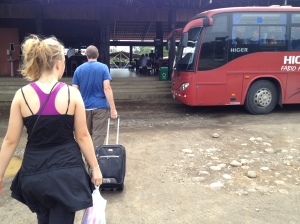
The family room that sleeps up to 5 people at Casa Marabella was very clean and the staff was English-speaking and very friendly. The hotel also offered a healthy breakfast in the morning. We were able to warm food in a microwave in their kitchen as well.
Our turtle tour was scheduled to start at 9:00 PM. John was coming down with a cold and he was anxious to “get it over with”. He wanted to be there and wanted to see the turtles, but a good bout of a cold is enough to make most people wish for a comfy chair and a good book, at the very least.
Our hotel was several paces to the left from where the boat docked. A man was standing at the dock with a sign that had our name on it, but he pointed us in the right direction and we took our luggage and found Casa Marabella on our own.
We were in room 11, a “family room” with a queen bed and one twin bunk over another queen. It was clean and for the first time since we’ve been to Costa Rica, the sheets stayed on the bed the whole night. There was no air conditioning and it was humid and warm, but the fans made it easy to endure. Also for the first time in Costa Rica, we did not awaken to the sounds of dogs barking.
We brought our own food on the trip due to our numerous alimentary “issues”, but there were four little grocery stores in town and we were able to buy corn tortillas and refried beans and then warm them in a microwave at Casa Marabella. We ate out by the river and watched the boats come and go from here to there along with some other people who were waiting for the tour. Across the river on the other side were the lights from another little town; likely one that had less tourist activity than Tortuguero village.
We walked back and forth through the town along the only path, which was only occasionally paved. In the unpaved areas where water had apparently pooled from the rain the night before, wet sand stayed wet throughout the entire afternoon under a thick and oppressively humid blanket of air. A collection of foot prints, shoe prints, dog tracks, and bicycle tracks in these wet and sandy areas were part of a collage that was filled with insignificant moments that led to other goings-on somewhere within the small village.
Along the path were fascinating dioramas of village life. Very few people were in their houses, but a few houses had the lights on inside. I would

This little stretch of the Tortuguero village walkway looks relatively deserted, but beyond the foliage are some weathered houses up on stilts.
hardly call these house “comfortable” with their hard floors and hard furnishings. We walked by one house where three kids were sitting on a wooden bench in a living room watching television. There was an older obese woman in the only other house in town where there was a television on and she was sitting in a padded rocking chair with her feet resting on flip flops to keep them off the hard floor. There was nothing lush or posh anywhere that I could see in the place, but I speculated that whatever soft furniture there was would be found in the more expensive tourist motels.
Each walk up and down the path revealed something new. It was a like a Renaissance festival, according to Lydian, and John and I both agreed. The little tiendas were “human-sized” and built to be observed in slow motion rather than the car-sized, fast-paced stores that we see in the United States. The smell of foreign food and the street light that kept going out and then flickering back on added to the ambience.
The sea turtle tour was cool. I generally shy away from things that involve the word “tour”, but this was okay. Though it still involved a group of other tourists, many of them behaving badly (like usual, of course), I wouldn’t have wanted to try to find my way through the rain foresty thickets out onto the dark beach to look for nesting sea turtles by myself. Our tour guide, a busty black woman wearing a special green “tour guide” polo shirt, admonished us to walk two-by-two through the trees to the beach because of “snakes”.
Snake bites are a major issue in these parts. Indeed, as I’m reading some of the anthropological information about the Afro-Caribbean coast out of books like What Happen: A Folk History of Costa Rica’s Talamanca Coast by Paula Palmer and Turtle Bogue: Afro-Caribbean Life and Culture in a Costa Rican Village by Harry G. Lefever, it seems that snake bites take the place of car accidents in these regions. As we were walking through the thick foliage along intersecting and meandering paths the leaves bristles ahead of us and the tour guide stopped for a moment to take a closer look at whatever caused the movement. I don’t know if it was a snake or not. All I know is that it was possible that it was a snake and I was glad to have a tour guide along, just in case it was.
The sand on the beach was dark and even though there was a quarter moon that night, it was incredibly hard to see the turtles without the help of the “spotters”. These people went out ahead of the tour groups with red lights (so that they wouldn’t scare the female turtles away with bright white lights) to find the turtles. We didn’t have to search for the turtles and risk falling into one of the giant hills that they dig on the beach or tripping over a gigantic piece of dark-colored drift wood to find them. Without the help of a guide, it would be difficult to see the green sea turtles this time of the year. They’re huge, but difficult to spot by the light of the moon.
I can’t imagine killing one of these creatures, unless of course, I was starving. They are so slow and they poor things perform such incredible feats; swimming vast distances and then crawling up on the beach to lay a bunch of eggs after digging a hole the size of a grave. They are completely harmless to humans, which I suppose is why they have been such good prey to the people in Tortuguero village and the surrounding area. I understand why people have gone to such efforts to try to promote their survival after seeing them heave themselves around on the beach and working diligently to bury their precious eggs. I also understand why they would be such an easy source of food. Falling in love with a creature like the sea turtle requires a complicated and delicate balance in an environment like this because the people here were able to survive in some part because the sea turtles were here. And arguably, when they were slaughtering them for food, they weren’t necessarily going to excess. It was when people saw the opportunity to slaughter the sea turtle for money that problems began to take shape, at least as far as I understand it.
As one of those boring family-types, I rarely go out at night except when there is some odd but palatable activity that could trump a relaxing evening reading, watching TV and regrouping for the next day. I really relish the night-time stuff that’s truly worth the while and this was definitely one of them. We spent at least 45 minutes chatting with an Israeli family with twin boys and a seven year old girl before the tour even started. They were staying in Costa Rica for a month (the kids had 3 weeks off from school due to Holy Days, apparently) and they talked with us about the differences between Costa Rica and India. I thought it was interesting and amazing that people in Israel could take 1 month of work and school off each year to travel. People in the United States often don’t even take two week vacations. They told us about the sea turtles in Israel (I didn’t know there were sea turtles in Israel). We sat outside in the Sector 4 shelter in the dark waiting for the turtle spotters to find turtles while we chatted with Jewish Israeli’s. A lot of people apparently get really impatient during this part of the turtle tour because the tour guide was especially nervous and reassuring as we sat there in our group, but I liked the wait.

Lydian and John walking back to the restaurant after the river ride back from Tortuguero National Park. Note the big bus sitting there. Most of the tourists climbed into the bus to go back to San Jose.
The Israeli man that I was talking to turned his camera on to take a picture without the flash on the beach and he was pulled aside and given a “what-for” by the busty black tour guide and two turtle spotters. They threatened to take his camera away if he had taken any pictures (which he hadn’t). John tried to make the Israeli man feel better after he got chided for the misbehavior.
Walking through the trees with only flashlights reminded me of Halloween and haunted houses and corn field mazes. There was a bug with green glowing eyes on our return from the beach. John said it looked like the kind of thing he would build out of some clay and LED lights. I agreed and again had reason to think about how fake all the real stuff at Tortuguero village looked to me.
The entire turtle tour lasted about 2 hours and 15 minutes from the time we left the hotel, but 45 minutes was spent just sitting in Sector 4 waiting. The tour guide told us that the tour could last from 45 minutes to 2 hours (not including the wait in Sector 4) depending upon how easy it was to find turtles performing the four processes that were open for public viewing (laying eggs, covering the eggs with sand, camouflaging the eggs, and going back out to sea). We weren’t allowed to watch turtles coming in from sea because this could frighten them off.